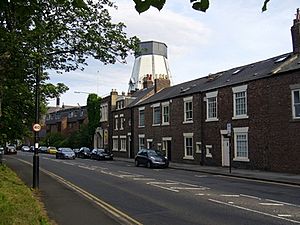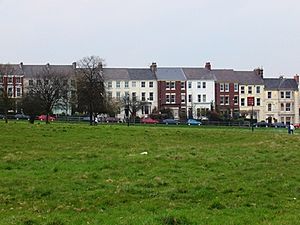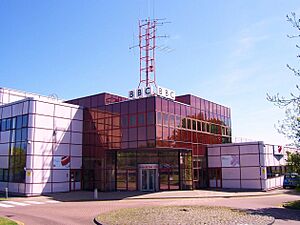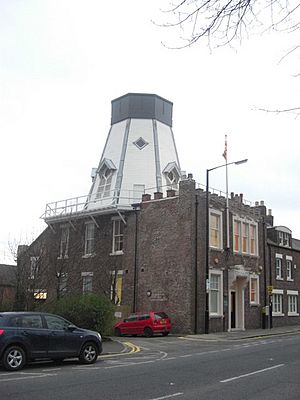Spital Tongues facts for kids
Spital Tongues is a cool area in Newcastle upon Tyne, located just northwest of the city center. Its unique name comes from "spital," which means "hospital," and "tongues," meaning small pieces of land. North of Spital Tongues is the Town Moor, a large open space. To the east, you'll find Castle Leazes and Leazes Park.
Quick facts for kids Spital Tongues |
|
|---|---|
 Chimney Mill, 2006 |
|
 Belle Grove Terrace, 2006 |
|
| Metropolitan borough | |
| Metropolitan county | |
| Region | |
| Country | England |
| Sovereign state | United Kingdom |
| Post town | NEWCASTLE UPON TYNE |
| Postcode district | NE2 |
| Dialling code | 0191 |
| Police | Northumbria |
| Fire | Tyne and Wear |
| Ambulance | North East |
| EU Parliament | North East England |
| UK Parliament |
|
Contents
- Interesting Buildings and Places
- Fenham Barracks: A Historic Army Base
- BBC Broadcasting Centre: The Pink Palace
- Huntsmoor House: From Soldiers to Students
- Chimney Mill: An Old Windmill
- Victoria Tunnel: A Secret Underground Path
- Whiteknights: A House with Many Names
- Belle Grove Public House: A Local Landmark
- Belle Grove Terrace: Home to Famous People
- George Arrowsmith's: A Historic Shop
- Benson Memorial Church: A Community Hub
- Moorbank Botanic Garden: A Place for Plants
- See also
Interesting Buildings and Places
Fenham Barracks: A Historic Army Base
Fenham Barracks was built in Spital Tongues in 1806. Many buildings here are very old and protected. This former army base is now used for student housing. The Northumberland Fusiliers were based here during World War II. Today, the Queen's Own Yeomanry still has a presence on the site.
BBC Broadcasting Centre: The Pink Palace
The BBC Broadcasting Centre is a big building known as the 'Pink Palace'. It stands at the corner of Hunters Road and Barrack Road. It opened in 1986, bringing all of the BBC's TV and radio work in Newcastle together. This center is now the main office for BBC North East and Cumbria. It broadcasts three radio stations and regional TV shows.
Huntsmoor House: From Soldiers to Students
Huntsmoor House on Hunters Road was built in 1899. It was first a home for soldiers from Fenham Barracks. Later, it became a place where clothes were pressed. Many workers here were adults with learning difficulties. They would sometimes ask children playing nearby to buy sweets for them. A favorite treat was Victory V lozenges. The child running the errand would get half a lozenge as a reward. After that, it was a warehouse for books. Now, Huntsmoor House is student accommodation. It's a unique red brick building with a cool tower and carved shields.
Chimney Mill: An Old Windmill
The Chimney Mill was built in 1782 on Claremont Road. It replaced an older windmill. This mill is special for many reasons. It is the only surviving smock mill in the area. It was also the first 5-sailed smock mill in Britain. A famous engineer named John Smeaton designed it. He also designed a famous lighthouse!
The mill used wind power until 1891. It stopped working in 1892. Later, it became a clubhouse for a golf club. The club moved in 1907. The mill's sails were removed in the 1920s and 1930s. In the 1970s, an architect bought and fixed up the building. It became design studios and offices. From 1983 to 2007, it was used by a fashion design company. Now, it is a dental practice and offices.
Victoria Tunnel: A Secret Underground Path
The Victoria Tunnel was built to move coal. It went from Spital Tongues Colliery to the River Tyne. The tunnel is about 2.5 miles (4 km) long and up to 85 feet (26 m) deep. About 200 men built it between 1839 and 1842. The owners built it underground because they couldn't build a railway above ground. The entrance in Spital Tongues was near Belle Grove West and Ancrum Street.
The tunnel stopped being used for coal in 1860. For 80 years, it was mostly empty. For a short time, someone tried to grow mushrooms in it! During World War II, it became an air raid shelter. About £37,000 was spent to make space for 9,000 people. Many entrances were added. Some of these entrances can still be seen today. One is on Claremont Road, next to the Hancock Museum. The Spital Tongues entrance was filled in and is not accessible.
After the war, most of the tunnel's features were removed. All entrances except one were closed. This one entrance was on private land. Now, visitors can take guided tours of the tunnel through this entrance.
Whiteknights: A House with Many Names
The house now called Whiteknights was first known as New House. In 1766, it became a hospital for people with mental health challenges. It was renamed St. Luke's. Then, in 1795, it became Belle Grove Retreat. This name later inspired other street names in Spital Tongues. These include Belle Grove Terrace and Belle Grove West. In 1857, Belle Grove Retreat became a private house again. It got its current name, Whiteknights, in 1900. It is a protected historic building.
Belle Grove Public House: A Local Landmark
The Belle Grove was a public house, or pub, on the corner of Belle Grove Terrace and Ancrum Street. It opened in 1857 and closed in 2008. The house next door, at No. 19, is now part of the pub. This house was once the home of the artist Ralph Hedley. He lived there until he passed away in 1913. A special plaque marks this connection. The house became part of the pub in 1923.
Belle Grove Terrace: Home to Famous People
No. 13 Belle Grove Terrace was once home to T. Dan Smith. He was the leader of Newcastle City Council from 1960 to 1965. He wanted to make Newcastle like Brasília, a famous city in Brazil. The 15-story Mill House tower block in Spital Tongues is one of many tall buildings built during his time. T. Dan Smith lived in a top-floor flat there from the early 1980s until he died in 1993.
The actor Alun Armstrong lived next door to T. Dan Smith. He was studying Fine Art at Newcastle University at the time.
George Arrowsmith's: A Historic Shop
The shop on the corner of Belle Grove West and Hunter's Road is historically interesting. It was once George Arrowsmith's general store. It opened in 1903. The Arrowsmiths were a very well-known family in Spital Tongues. George and his wife Margaret had fifteen children! Members of the Arrowsmith family still live in Spital Tongues today.
The old Arrowsmith shop is still a shop today. It is one of only a few shops left in the area. In the 1920s, Spital Tongues had a Co-operative store and 27 other shops.
Benson Memorial Church: A Community Hub
The Benson Memorial Church on Ancrum Street opened in 1867. It started as a Sunday school. This recognized John Benson, who set up the first school in 1845. Today, the building is still used by the community. It is now home to the Apostolic Church.
Moorbank Botanic Garden: A Place for Plants
Moorbank Botanic Gardens is located on Hunters Moor. It is at the top of Claremont Road. The Gardens opened in 1923. They were a plant research station for Newcastle University. The gardens are not open to the public every day. However, groups can book visits. They also open on special days linked to the National Gardens Scheme. The garden had received money from the Heritage Lottery Fund. In 2012, Newcastle University decided to stop supporting the garden.
See also
 In Spanish: Spital Tongues para niños
In Spanish: Spital Tongues para niños



